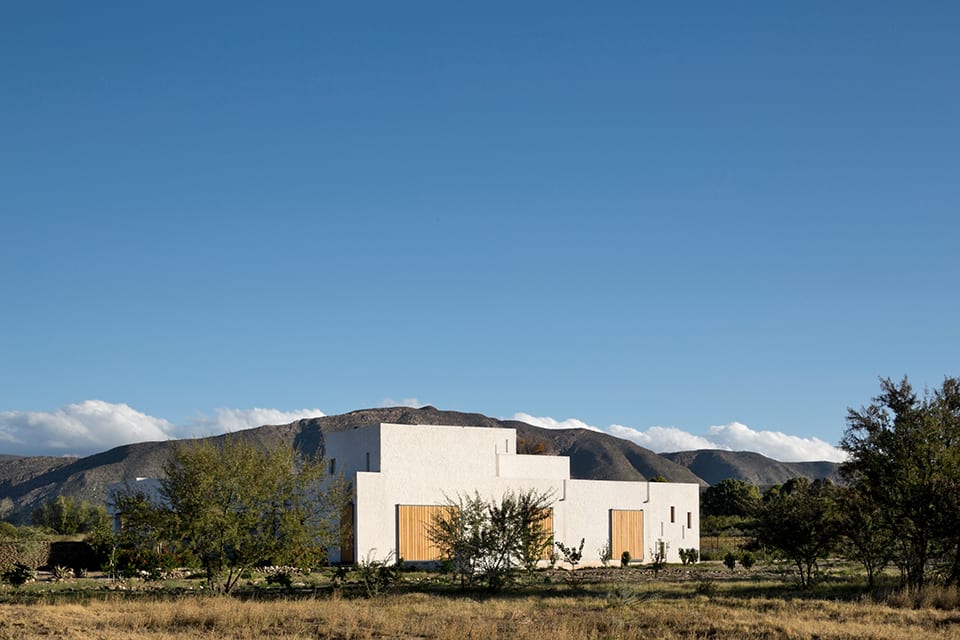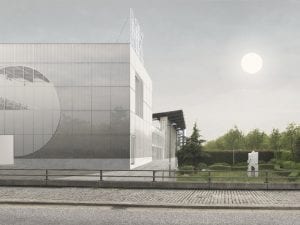Approximately one third of the world’s land mass is covered by desert; a selection of innovative architects take on the challenge of these terrains.
“I am supportive of an art that takes into account the direct effect of the elements as they exist from day to day,” wrote the pioneering land artist Robert Smithson in his 1972 essay Cultural Confinement. Practitioners like Smithson and his modern-day disciples who move beyond the confines of traditional gallery spaces in favour of the outdoors find a most worthy opponent in extreme conditions, perhaps none more so than the hot, dry and unforgiving desert. Its expanses have long seduced creatives of all disciplines – from authors and musicians to painters and architects – and with good reason. Despite an array of contemporary technological advancements, the terrain is in many ways still elusive and menacing, and as such, simply beguiling.
Those individuals bold enough to seek shelter in the desert – even if only temporarily – face a profusion of challenges that include heating and cooling, as well as securing safe and reliable sources of water and electricity. However, as the familiar adage goes, with great risk comes great reward. Breathtaking views, an abundance of space, an unmatched sense of tranquillity and an unflinching understanding of the surrounding elements seem to come as standard with life in an arid plane. And in today’s world of global feeds, post-truths and dense populations, the notion of space and reconnecting with nature seems to be an unattainable oasis. These contrasting ideals are the subject of a recent book published by Phaidon. Conceived by the editors of the publishing house and written by Izabela Anna Moren, the compendium highlights 50 residences – from USA, Australia, Europe, Asia and beyond – that consider the distinctive tasks, and joys, presented by life in one of the world’s most fickle and unrelenting environments.
The paradoxical nature of the subject matter is poignantly captured in the introduction: “To build in any environment, one must ask: What is a desert? Words typically used to describe such arid landscapes include: uninhabited, unoccupied, unpeopled, abandoned, evacuated, tenantless, unfrequented, neglected, secluded, isolated, desolate, lonely, solitary. All of these words emphasise the negative space and contribute to a sense of nothingness. A desert may simply be defined by its lack.” However, emptiness in a world of excess offers both opportunity and adversity.
Through the dozens of diverse and surprising examples included, the author makes the case that, not unlike the above argument enumerated by Smithson, by stepping outside of the well-established comforts of the built world and seeking new solutions in unforeseen environments, it not only becomes possible to innovate through art and architecture, but also to gain deeper insight into what it takes to live, and build, embracing new corners of the world away from megacities, high rises and global infrastructure. “The desert is famously inhospitable,” notes Moren, who was first drawn to the geography when introduced to the artist Andrea Zittel’s sprawling live-work compound in Joshua Tree National Park, California, titled Wagon Station Encampment. “Out of necessity, you have to think, ‘How do I create wind tunnels? How do I create cross-ventilation? How do I heat water?’” She continues, “It’s not like a modern apartment in a major city like London or Berlin. You cannot afford to ignore the way that you live and the solutions you need to survive.”
Several common denominators such as remote location, sustainable practices and an ability to re-engage humans with the landscape bind all of the divergent constructions together. However, each home falls into one of three distinct categories: Built to Embrace, Built Within or Built to Resist the Desert. The former classification is defined as architecture that “is characterised by various possible forms of dedication to nature, be it through enhancing panoramic vistas, following the trajectory of its light, or imitating its organic colours and shapes. These are houses that allow one to experience the organic world from within as much as from without.”
Amongst the key buildings highlighted is the thick-walled and aesthetically satisfying Swartberg House in the Karoo Desert of South Africa. Built in 2013 by the firm Openstudio Architects, this stark-white citadel shields its inhabitants from the region’s harsh temperatures, which range from minus six to 40 degrees Celsius, whilst offering sweeping views of the surrounding grasslands and vineyards from the strategically placed windows and a generously sized roof terrace. “In the context of an environment with such overwhelming visual stimuli, strategies for inserting oneself into the desert become increasingly elaborate,” Moren explains. “A structure’s entire orientation [has] to be meticulously choreographed to coincide with nature’s movements.”
The Swartberg House finds itself in good company in this chapter. Also present is the appropriately titled House to Watch the Sunset by Not Vital. Situated in Aladab, Niger, this dutifully geometric, mud-and-straw construction bears a striking resemblance to the ancient Pyramid of the Sun in Mexico and, through the incorporation of purposefully located doors and windows, invites guests to take their time gazing upon the vast and level ground and seemingly endless blue skies. As the book attests: “These structures not only guide your eyes, but your body through space. It comes down to fundamental questions: what’s the first thing you see in the morning when you wake up? With these houses, the external topography is as exposed to you as you are to it.” Creating pathways between geology and the personal experience, the buildings create a sense of paralleled rhythm between living, breathing and walking through rooms within an undulating landscape.
Artist Doug Aitken further questions humanity’s reconnection to nature with Mirage. Fabricated in 2017, the monolithic piece was installed in Palm Springs as part of the inaugural edition of the Desert X biennial. As its title suggests, this sculpture-cum-structure has the capability to mirror the mountains of the Coachella Valley surroundings or become completely camouflaged, depending on the time of day. Aitken’s phantasm serves as a mechanism for self-reflection.
The preceding section of the publication, dubbed Built Within the Desert, features projects, that are “together with nature and attempt to give back to it, if only by not depleting it further. As architecture has a claim to permanence, it is a virtue to include solutions that compensate for prevalent lack, exploit the benefits of available materials, and generate new resources from existing ones, thereby setting up a circular cycle able to sustain itself without – or with only minimal – outside intervention. Fitting this bill is the recent Tunisian construction Deserti Tascabili DJ Complex #2 by AutonomeForme Architettura. Realised in 2017 and inspired by the 2009 text You Must Change Your Life by the German philosopher Peter Sloterdijk, this stately property offers both sea and desert vistas and reduces its environmental impact with astonishingly dense walls that allow for natural cooling – allowing free-flowing spaces.
Also of note is one of the most sought-after resorts in America: Amangiri. Established in 2009 by I-10 Studio, this Utah sanctuary has become synonymous with idealised luxury – filling google image searches with sunset-lit patios and classical Americana rock formations. The modest scale and earth-tone walls invite guests to gaze outwardly, fixing their sights on the monuments and sweeping parks that surround the property. As Moren illustrates: “Much of its beauty lies in the fact that it does not try to overpower the breathtaking views but rather supports them, silently.”
Homes engineered to manoeuvre the elements, to stand up to extreme temperatures and arid conditions comprise the final category of structure outlined. Moren continues: “Depending on the technological possibilities available, architects have introduced innovations to improve their buildings’ abilities to withstand the world outside. Recent discourse has mainly focused disaster preparedness, with architecture and science uniting to develop projects that can withstand earthquakes, hurricanes, wildfires or tsunamis. In the desert, such defiance is needed on a daily basis.”
This ultimate grouping comprises projects like a 2011 off-grid prototype by Michael Leckie and Javier Campos: Zacatitos 03. Named after the Baja California Sur community in which the home is located, this construction calls upon minimalism to combat the harsh exteriors. Concrete, glass, steel and aluminium work together, in harmony, to maximise ventilation and minimise heat retention. Though stylish in appearance, this Mexican abode is a feat of engineering and design. As this chapter’s accompanying copy expounds, the practitioners behind Zacatitos 03 “use methods to overpower or outwit nature, with the benefit of ingenuity and funds – to build works of extremely high quality in a topography that challenges the basic skill of survival.” Similarly, Guilhem Eustache’s 2014 Fobe House from Marrakech exemplifies ecologically minded architecture through the use of artisan-crafted, double-thick walls that facilitate temperature regulation. Reminiscent of a modular form conceived by Sol LeWitt, this bright-white desert mirage marries form and function to create a dreamlike environment fit for its cinematographer client.
As the Fobe House and Zacatitos 03, and the previous examples, illustrate, desert constructions are not, by any means, devoid of beauty. But buildings cannot rely on aesthetics to survive. Ingenuity, creativity and wit is required. “It is modern progress that allows us to spend extended periods of time in hostile environments and attempt to find a balance between radically taming one’s surroundings and slowly, thoughtfully adjusting to them,” the text summarises.
In a world where industry has accrued astonishing amounts of environmental damage – with just 12 years to cap global warming at 1.5 degrees Celsius – the cataloguing of these projects comes at a time of need for the planet. Exploring the ingenuity of architecture to work with the land – as far as it extends – in constructive, meaningful and unprecedented ways, the publication is a testimony to designers recognising the hold that geology has on our very existence. In 1972, Smithson stated that “nature is never finished.” Perhaps, however, this should be updated, taking into account today’s ecological state. Nature – in its supremacy, fragility and vulnerability – should never be taken for granted.
Stephanie Strasnick








